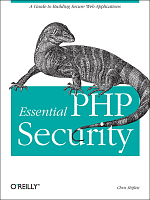Essential PHP Security Is Finished!
10 Sep 2005A little over a month ago, I finally finished writing Essential PHP Security, a guide to secure PHP programming that I've been working on in my spare time for quite a while.
I'm really happy with the results. The people at O'Reilly have been great to work with, and I was lucky enough to have some of the best technical reviewers an author could ask for (Adam, David, George, and John). The result is a lean 150 page guide that covers what I feel are the most important topics with which a PHP developer should be familiar.
The book is due to be published in October (in time for the Zend PHP Conference and Expo), but you can buy it from Amazon today. As Adam jokingly suggests in his infamous email signature, "avoid the holiday rush - buy your copy today!"
I focus on Apache and MySQL, but the principles apply to any platform. In fact, web developers using languages other than PHP might learn something. I hope so. :-)
Each chapter focuses on a specific category of PHP development, and you are shown the most common and dangerous attacks associated with that particular category. Here is the final table of contents:
Preface
Foreword by Andi Gutmans
1. Introduction
PHP Features
Register Globals
Error Reporting
Principles
Defense in Depth
Least Privilege
Simple Is Beautiful
Minimize Exposure
Practices
Balance Risk and Usability
Track Data
Filter Input
Escape Output
2. Forms and URLs
Forms and Data
Semantic URL Attacks
File Upload Attacks
Cross-Site Scripting
Cross-Site Request Forgeries
Spoofed Form Submissions
Spoofed HTTP Requests
3. Databases and SQL
Exposed Access Credentials
SQL Injection
Exposed Data
4. Sessions and Cookies
Cookie Theft
Exposed Session Data
Session Fixation
Session Hijacking
5. Includes
Exposed Source Code
Backdoor URLs
Filename Manipulation
Code Injection
6. Files and Commands
Traversing the Filesystem
Remote File Risks
Command Injection
7. Authentication and Authorization
Brute Force Attacks
Password Sniffing
Replay Attacks
Persistent Logins
8. Shared Hosting
Exposed Source Code
Exposed Session Data
Session Injection
Filesystem Browsing
Safe Mode
A. Configuration Directives
B. Functions
C. Cryptography
I plan to launch a companion web site in time for the book's publication, and I will post code samples (I created a few utilities in order to demonstrate some attacks) and aggressively keep up with any errata that is discovered.
Now, I can finally start contributing to other things again. :-) I hope you enjoy the book, and I hope it helps.

